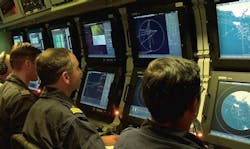General Dynamics to maintain and upgrade combat system computers and software aboard U.S. Navy submarines
WASHINGTON – Submarine electronics experts at General Dynamics Corp. will maintain and upgrade the U.S. Navy AN/BYG-1 submarine combat system under terms of a $15.9 million order announced Tuesday.
Officials of the Naval Sea Systems Command in Washington are asking the General Dynamics Mission Systems segment in Fairfax, Va., for engineering services for the design, integration, and test of the AN/BYG-1 tactical control system.
General Dynamics is upgrading the AN/BYG-1 submarine combat system with commercial off-the-shelf (COTS) computers. The company is replacing central processors with COTS computers, and is refreshing submarine combat system processors with new COTS technologies in periodic upgrades called technology insertions.
The AN/BYG-1 system is a counterpart to the Navy's Advanced Rapid COTS Insertion (A-RCI) program that uses COTS computers in submarine sonar signal processing systems.
Submarine crews equipped with the AN/BYG-1 combat control system are able to analyze submarine sensor contact information to track submarine and surface vessels in open-ocean and coastal waters; aim and fire heavyweight torpedoes against enemy submarines and surface ships; receive strike warfare orders, plan strike missions and employ Tomahawk land-attack cruise missiles; and receive and synthesize sensor data and external tactical intelligence to produce an integrated tactical picture for situational awareness.
These upgrades are for the combat systems and computers aboard ballistic-missile submarines, cruise-missile submarines, and fast-attack submarines.
The AN/BYG-1 program includes combat control system for Virginia-class attack submarines, as well as upgraded combat control systems for Los Angeles- and Seawolf-class attack submarines and Ohio-class ballistic-missile and cruise-missile submarines. General Dynamics also is providing AN/BYG-1 system upgrades for Australian Collins-class attack submarines.
The AN/BYG-1 modernization program separates development of the tactical control system (TCS) and the weapons control system (WCS) to enable independent yet parallel development and certification of these computer systems, General Dynamics officials say. Each of these systems uses a variety of software algorithms developed by industry, government, and academia.
The TCS computer hardware portion of BYG-1 integrates sensor inputs to provide a secure common operational picture and improved situational awareness that blends information sonar, electronic support measures, radar, navigation, periscopes, and communications systems. The TCS system architecture allows for rapid COTS insertion to accommodate and integrate additional functionality and sensors.
One of the benefits of rapid COTS technology upgrades to submarine combat systems is the ability for the Navy to learn from real-world experience to make quick improvements. Recent Navy recommendations, for example, were to acquire automation technology to help the operator in areas of high contact density.
On this order, General Dynamics will do the work in Fairfax, Va., and should be finished by July 2023. For more information contact General Dynamics Mission Systems online at https://gdmissionsystems.com, or Naval Sea Systems Command at www.navsea.navy.mil.
About the Author
John Keller
Editor-in-Chief
John Keller is the Editor-in-Chief, Military & Aerospace Electronics Magazine--provides extensive coverage and analysis of enabling electronics and optoelectronic technologies in military, space and commercial aviation applications. John has been a member of the Military & Aerospace Electronics staff since 1989 and chief editor since 1995.
